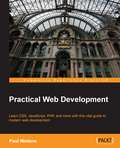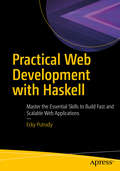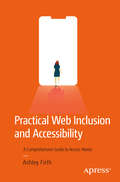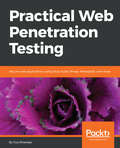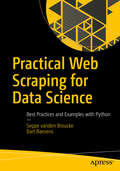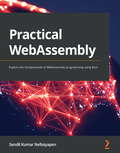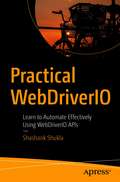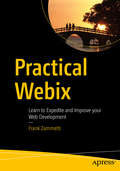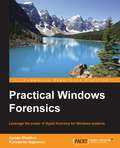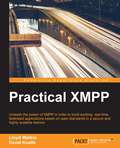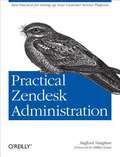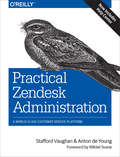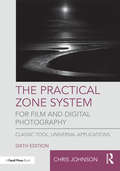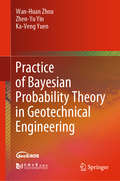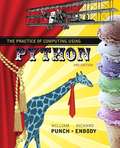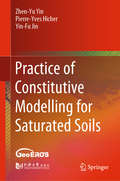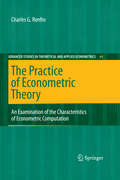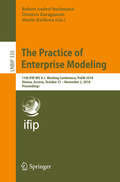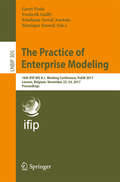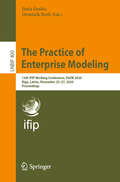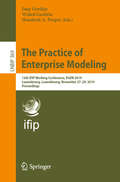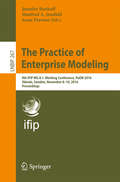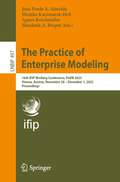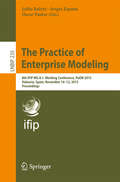- Table View
- List View
Practical Web Development
by Paul WellensThis book is perfect for beginners who want to get started and learn the web development basics, but also offers experienced developers a web development roadmap that will help them to extend their capabilities.
Practical Web Development with Haskell: Master the Essential Skills to Build Fast and Scalable Web Applications
by Ecky PutradyLearn how to advance your skill level of Haskell, and use this language for practical web development. This book uses a direct, no nonsense approach, so you no longer need to spend extra time reading the documentation, blog posts, and forums to understand how to use Haskell – all that knowledge is provided in one coherent resource. You'll start by reviewing how multiple facets of web development are done in Haskell, such as routing, building HTMLs, interacting with databases, caches, and queues, etc. You'll then move on to using notable libraries, such as "scotty" for routings, "digestive-functor" for input validation, and "postgresql-simple" for interacting with databases. In the later chapters, you'll learn how all of these libraries can be used together by working on a fully functioning project deployed on Heroku. What You'll Learn Set up a productive Haskell development environmentReview basic tasks that are encountered when building web applications.Explore how to interact with external systems, such as databases, queues, and RESTful APIs. Build a RESTful API, website, building views and form validation.Who This Book Is ForSoftware developers familiar Haskell and would like to apply the knowledge on real world applications and software developers new to Haskell.
Practical Web Inclusion and Accessibility: A Comprehensive Guide to Access Needs
by Ashley FirthThe web has to be inclusive. One in five people living in the UK have a disability. From Microsoft’s “inclusive design” movement - creating adaptive controllers for users with a range of disabilities - to Beyoncé’s site being sued for failure to be accessible, the importance of considering access needs is gaining mainstream attention. Recognizing and catering for a range of disabilities in our online platforms is key to achieving a truly inclusive web.You’ll be guided through a broad range of access needs, the barriers users often face, and provided practical advice on how your sites can help rather than hinder. Going beyond advice tailored solely for developers, this book offers potential improvements for designers, developers, user experience professionals, QA and testers, so that everyone involved in building a website can engage with the concepts without the need to understand how to code.Learn about the very latest technology - such as natural language processing and smart home tech - and explore its application accessibly. This book comes complete with practical examples you can use in your own sites and, for the first time in any web accessibility book, access needs experienced by those with mental health disorders and cognitive impairments are comprehensively covered. Applicable to both new projects and those maintaining existing sites and looking for achievable improvements on them, Practical Web Inclusion and Accessibility gives you all the information you need to ensure that your sites are truly accessible for the modern, inclusive web.What You Will LearnUnderstand the vast range of disabilities that have online access needsApply the practical steps required to cater for those needsUse new technology to open up exciting avenues for the sites you create and maintainApproach accessibility from a full spectrum of online disciplinesStart thinking about users with specific disabilities and how it impacts your workWho This Book Is ForAnyone who wants to have a greater understanding of the inclusive web and considerations that should be made. You do not need to have coding knowledge.
Practical Web Penetration Testing: Secure web applications using Burp Suite, Nmap, Metasploit, and more
by Gus KhawajaLearn how to execute web application penetration testing end-to-endKey FeaturesBuild an end-to-end threat model landscape for web application securityLearn both web application vulnerabilities and web intrusion testingAssociate network vulnerabilities with a web application infrastructureBook DescriptionCompanies all over the world want to hire professionals dedicated to application security. Practical Web Penetration Testing focuses on this very trend, teaching you how to conduct application security testing using real-life scenarios.To start with, you’ll set up an environment to perform web application penetration testing. You will then explore different penetration testing concepts such as threat modeling, intrusion test, infrastructure security threat, and more, in combination with advanced concepts such as Python scripting for automation. Once you are done learning the basics, you will discover end-to-end implementation of tools such as Metasploit, Burp Suite, and Kali Linux. Many companies deliver projects into production by using either Agile or Waterfall methodology. This book shows you how to assist any company with their SDLC approach and helps you on your journey to becoming an application security specialist.By the end of this book, you will have hands-on knowledge of using different tools for penetration testing.What you will learnLearn how to use Burp Suite effectivelyUse Nmap, Metasploit, and more tools for network infrastructure testsPractice using all web application hacking tools for intrusion tests using Kali LinuxLearn how to analyze a web application using application threat modelingKnow how to conduct web intrusion testsUnderstand how to execute network infrastructure testsMaster automation of penetration testing functions for maximum efficiency using PythonWho this book is forPractical Web Penetration Testing is for you if you are a security professional, penetration tester, or stakeholder who wants to execute penetration testing using the latest and most popular tools. Basic knowledge of ethical hacking would be an added advantage.
Practical Web Scraping for Data Science: Best Practices And Examples With Python
by Bart Baesens Seppe Vanden BrouckeThis book provides a complete and modern guide to web scraping, using Python as the programming language, without glossing over important details or best practices. Written with a data science audience in mind, the book explores both scraping and the larger context of web technologies in which it operates, to ensure full understanding. The authors recommend web scraping as a powerful tool for any data scientist’s arsenal, as many data science projects start by obtaining an appropriate data set.Starting with a brief overview on scraping and real-life use cases, the authors explore the core concepts of HTTP, HTML, and CSS to provide a solid foundation. Along with a quick Python primer, they cover Selenium for JavaScript-heavy sites, and web crawling in detail. The book finishes with a recap of best practices and a collection of examples that bring together everything you've learned and illustrate various data science use cases. What You'll LearnLeverage well-established best practices and commonly-used Python packages Handle today's web, including JavaScript, cookies, and common web scraping mitigation techniques Understand the managerial and legal concerns regarding web scrapingWho This Book is ForA data science oriented audience that is probably already familiar with Python or another programming language or analytical toolkit (R, SAS, SPSS, etc). Students or instructors in university courses may also benefit. Readers unfamiliar with Python will appreciate a quick Python primer in chapter 1 to catch up with the basics and provide pointers to other guides as well.
Practical WebAssembly: Explore the fundamentals of WebAssembly programming using Rust
by Sendil Kumar NellaiyapenUnderstand the basic building blocks of WebAssembly and learn, install, and use various tools from the Rust and WebAssembly ecosystemKey FeaturesUnderstand the Rust programming language and WebAssembly concepts for web developmentBuild web, mobile, and embedded apps using WebAssemblyEnhance the scalability and resilience of your web appsBook DescriptionRust is an open source language tuned toward safety, concurrency, and performance. WebAssembly brings all the capabilities of the native world into the JavaScript world. Together, Rust and WebAssembly provide a way to create robust and performant web applications. They help make your web applications blazingly fast and have small binaries. Developers working with JavaScript will be able to put their knowledge to work with this practical guide to developing faster and maintainable code. Complete with step-by-step explanations of essential concepts, examples, and self-assessment questions, you'll begin by exploring WebAssembly, using the various tools provided by the ecosystem, and understanding how to use WebAssembly and JavaScript together to build a high-performing application. You'll then learn binary code to work with a variety of tools that help you to convert native code into WebAssembly. The book will introduce you to the world of Rust and the ecosystem that makes it easy to build/ship WebAssembly-based applications. By the end of this WebAssembly Rust book, you'll be able to create and ship your own WebAssembly applications using Rust and JavaScript, understand how to debug, and use the right tools to optimize and deliver high-performing applications.What you will learnExplore WebAssembly and the different tools available in the WebAssembly ecosystemUnderstand the raw WebAssembly binary and the WebAssembly text formatUse the Web and JavaScript API with wasm-bindgenOptimize Rust and WebAssembly for high performanceRun and debug WebAssembly and Rust codeExplore various tools available in the RustWASM ecosystemWho this book is forThis book is for JavaScript developers who want to deliver better performance and ship type-safe code. Rust developers or backend engineers looking to build full-stack applications without worrying too much about JavaScript programming will also find the book useful.
Practical WebDriverIO: Learn to Automate Effectively Using WebDriverIO APIs
by Shashank ShuklaLearn how to quickly set up the test automation tool WebdriverIO, one of the major Node.js-based test frameworks. Software testing is here to stay, and an integral part of this is test automation. Dive into the amazing possibilities that WebDriverIO offers to automate browser interactions for a user of any web application. You will learn to automate a vast range of actions that a user takes to interact with the browser. From a simple click to more complex user actions such as frame switches, selecting from drop-downs, and file downloads using WebDriverIO APIs. You will also learn about assertions, timeouts, waits, parallel testing frameworks, and the general pros and cons of WebDriverIO.With over 150 working code samples demonstrating various test scenarios that you require in your day-to-day automation testing, this book is your practical handbook to WebDriverIO. What You'll Learn Set up and install WebdriverIO efficientlyRun parallel execution using WebdriverIOReview the pros, cons and challenges you may face with WebdriverIOEnsure optimum usage and avoid common mistakes Who This Book Is ForThis book is ideal for test engineers who have a basic understanding of test automation with Selenium, developers who want to implement this testing tool for internal testing, Test Managers/IT Project Managers who want to get some general understanding of this tool and its advantage, and students who want to pursue career in test automation.
Practical Webix: Learn To Speed Up Your Web Development
by Frank ZammettiLearn to create speedy cross-platform applications with ease using Webix. You will begin with an introduction to Webix and basic usage, exploring the interface components and utilities it offers, as well as the tools available (skin builder, form builder, and code snippet testing facility).You’ll understand how Webix can integrate with other popular libraries and frameworks including Angular, Vue, React and more (as well as third-party components like dHTMLx and rich text editors). You will learn tangential topics including communication with back-end systems (Node.js and common related tooling), packaging as a Cordova app and, of course, you will learn how to use Webix following the Progressive Web App delivery mechanism.Offering a complete solution in a single bundle, this JavaScript UI framework provides a rich set of interface components, application architecture direction and commonly-needed utility and ancillary capabilities.Every topic will be taught a practical way, explored within the context of building real-world working apps, not through unrelated snippets. Bringing 25 years of professional development experience to the table, author Frank Zammetti uses his unique levity to teach you how to get up and running with this new and upcoming framework. What You’ll Learn Explore the capabilities and UI widgets it provides and the features that make it stand out from its competitorsBuild one web technology-based app that works on both desktops and mobile devices (Android and iOS)Create and hook a Webix app up to a Node.js/Express-based RESTful server API for data storageMobilize a Webix app using both PhoneGap and Progressive Web App techniquesEnhance your Webix and general development skills in the most fun way possible: by building a gameWho This Book Is For Moderately experienced front-end developers who want to learn about Webix and the power it brings to client-side development. Developers looking to use their web development skills to build cross-platform apps that work on both desktop and mobile devices with Webix as the foundation.A working knowledge of CSS, HTML and JavsScript is assumed, though you don’t need to be an expert.
Practical Windows Forensics
by Konstantin Sapronov Ayman ShaabanLeverage the power of digital forensics for Windows systems About This Book * Build your own lab environment to analyze forensic data and practice techniques. * This book offers meticulous coverage with an example-driven approach and helps you build the key skills of performing forensics on Windows-based systems using digital artifacts. * It uses specific open source and Linux-based tools so you can become proficient at analyzing forensic data and upgrade your existing knowledge. Who This Book Is For This book targets forensic analysts and professionals who would like to develop skills in digital forensic analysis for the Windows platform. You will acquire proficiency, knowledge, and core skills to undertake forensic analysis of digital data. Prior experience of information security and forensic analysis would be helpful. You will gain knowledge and an understanding of performing forensic analysis with tools especially built for the Windows platform. What You Will Learn * Perform live analysis on victim or suspect Windows systems locally or remotely * Understand the different natures and acquisition techniques of volatile and non-volatile data. * Create a timeline of all the system actions to restore the history of an incident. * Recover and analyze data from FAT and NTFS file systems. * Make use of various tools to perform registry analysis. * Track a system user's browser and e-mail activities to prove or refute some hypotheses. * Get to know how to dump and analyze computer memory. In Detail Over the last few years, the wave of the cybercrime has risen rapidly. We have witnessed many major attacks on the governmental, military, financial, and media sectors. Tracking all these attacks and crimes requires a deep understanding of operating system operations, how to extract evident data from digital evidence, and the best usage of the digital forensic tools and techniques. Regardless of your level of experience in the field of information security in general, this book will fully introduce you to digital forensics. It will provide you with the knowledge needed to assemble different types of evidence effectively, and walk you through the various stages of the analysis process. We start by discussing the principles of the digital forensics process and move on to show you the approaches that are used to conduct analysis. We will then study various tools to perform live analysis, and go through different techniques to analyze volatile and non-volatile data. Style and approach This is a step-by-step guide that delivers knowledge about different Windows artifacts. Each topic is explained sequentially, including artifact analysis using different tools and techniques. These techniques make use of the evidence extracted from infected machines, and are accompanied by real-life examples.
Practical XMPP
by David Koelle Lloyd WatkinUnleash the power of XMPP in order to build exciting, real-time, federated applications based on open standards in a secure and highly scalable fashion About This Book * Learn about the fundamentals of XMPP and be able to work with the core functionality both server-side and in the browser * Build a simple 1-to-1 chat (the "Hello World" of XMPP), explore multi-user chat, publish subscribe systems, and work with a decentralized social network * Author Lloyd Watkins is a member of the XMPP standards committee Who This Book Is For If you want to learn about the fundamentals of XMPP, be able to work with the core functionality both server-side and in the browser then this book is for you.No knowledge of XMPP is required, or of TCP/IP networking. It's important that you already know how to build applications of some form, and are looking get a better understanding of how to implement XMPP for one or more of its many uses. You should be interested in the decentralized web, know HTML, and likely know JavaScript and NodeJS. You will probably know JSON, and hopefully XML (this is the native output of XMPP). What You Will Learn * Install and configure an XMPP server and use it to connect from a traditional desktop client and send a message * Build a simple server-side application that will respond to messages from our logged in desktop client * Install and run XMPP-FTW, connect to the server from the browser, and handle incoming/outgoing messages * Connect to a multi-user chat room, send/receive stanzas, add a room password, join a protected room, set the room's subject, and change a user's affiliation * Get to grips with the publish-subscribe extension of XMPP and use it to build a pusher system that can make any website real-time * Build a simple XMPP component and create an extension for XMPP-FTW that allows you to use your own custom format * Build an XMPP version of the classic game "Pong" In Detail XMPP (eXtensible Messaging and Presence Protocol) is a messaging protocol that enables communication between two or more devices via the Internet. With this book, developers will learn about the fundamentals of XMPP, be able to work with the core functionality both server-side and in the browser, as well as starting to explore several of the protocol extensions. You will not only have a solid grasp of XMPP and how it works, but will also be able to use the protocol to build real-world applications that utilize the power of XMPP. By the end of this book, you will know more about networking applications in general, and have a good understanding of how to extend XMPP, as well as using it in sample applications. Style and approach Through a number of hands-on projects, this book shows you how to build usable applications that highlights a feature of XMPP.
Practical Zendesk Administration
by Stafford Vaughan<p>In this hands-on guide, author Stafford Vaughan provides the most comprehensive set of best practices for setting up and using Zendesk, distilled from years of training companies how to launch this popular customer service software. You’ll learn the purpose, benefits, and pitfalls of each Zendesk feature, with examples of how you can configure it to match your company’s needs and processes.</p>
Practical Zendesk Administration
by Anton De Young Stafford VaughanImplementing the Zendesk customer service software as part of your company's operations can be time-consuming, but with the best practices and advice in this hands-on guide, you can shorten the procedure considerably. You'll learn the purpose, benefits, and pitfalls of each Zendesk feature, with examples of how to configure it to match your company's needs and processes.Written by written by two experienced Zendesk product trainers, this book is distilled from years of working in the trenches, launching customer implementations, and answering thousands of questions from participants throughout the world. With it, you'll be able to determine the best way to put Zendesk's vast potential to work for your company.Apply custom branding to your user-facing support portalMitigate risk by implementing various Zendesk security featuresManage profiles and permissions for users, agents, and administratorsCreate tickets from email, voice, chat, feedback tabs, and social mediaCapture and classify help requests through standard and custom fieldsUse techniques to build an efficient agent support processAutomate your business rules in Zendesk to streamline your workflowProvide your customers with self-service support
The Practical Zone System for Film and Digital Photography: Classic Tool, Universal Applications
by Chris JohnsonThis sixth edition of The Practical Zone System by Chris Johnson updates the classic manual on Ansel Adams's landmark technique for the digital age. For photographers working digitally or with film, in color or black and white, in the studio or on the go, this simple visual language helps to control contrast and, through a process called Previsualization, provides photographers with the power of free creative expression. This new edition discusses recent advances in technology and potentials for their use in zone photography, including HDR, smartphone cameras that shoot in raw format and smartphone light meters. Johnson demonstrates how the Zone System is a universal visual and conceptual language that dramatically simplifies the problem of creating and rendering complex lighting setups.
Practice of Bayesian Probability Theory in Geotechnical Engineering
by Wan-Huan Zhou Zhen-Yu Yin Ka-Veng YuenThis book introduces systematically the application of Bayesian probabilistic approach in soil mechanics and geotechnical engineering. Four typical problems are analyzed by using Bayesian probabilistic approach, i.e., to model the effect of initial void ratio on the soil–water characteristic curve (SWCC) of unsaturated soil, to select the optimal model for the prediction of the creep behavior of soft soil under one-dimensional straining, to identify model parameters of soils and to select constitutive model of soils considering critical state concept. This book selects the simple and easy-to-understand Bayesian probabilistic algorithm, so that readers can master the Bayesian method to analyze and solve the problem in a short time. In addition, this book provides MATLAB codes for various algorithms and source codes for constitutive models so that readers can directly analyze and practice.This book is useful as a postgraduate textbook for civil engineering, hydraulic engineering, transportation, railway, engineering geology and other majors in colleges and universities, and as an elective course for senior undergraduates. It is also useful as a reference for relevant professional scientific researchers and engineers.
The Practice Of Computing Using Python
by Richard Enbody William PunchNow in its Third Edition, Practice of Computing Using Python continues to effectively introduce readers to computational thinking using Python, with a strong emphasis on problem solving through computer science. The authors have chosen Python for its simplicity, powerful built-in data structures, advanced control constructs, and practicality. The text is built from the ground up for Python programming, rather than having been translated from Java or C++.
Practice of Constitutive Modelling for Saturated Soils
by Zhen-Yu Yin Pierre-Yves Hicher Yin-Fu JinThis book describes the development of a constitutive modeling platform for soil testing, which is one of the key components in geomechanics and geotechnics. It discusses the fundamentals of the constitutive modeling of soils and illustrates the use of these models to simulate various laboratory tests. To help readers understand the fundamentals and modeling of soil behaviors, it first introduces the general stress–strain relationship of soils and the principles and modeling approaches of various laboratory tests, before examining the ideas and formulations of constitutive models of soils. Moving on to the application of constitutive models, it presents a modeling platform with a practical, simple interface, which includes various kinds of tests and constitutive models ranging from clay to sand, that is used for simulating most kinds of laboratory tests. The book is intended for undergraduate and graduate-level teaching in soil mechanics and geotechnical engineering and other related engineering specialties. Thanks to the inclusion of real-world applications, it is also of use to industry practitioners, opening the door to advanced courses on modeling within the industrial engineering and operations research fields.
The Practice of Econometric Theory
by Charles G. RenfroEconometric theory, as presented in textbooks and the econometric literature generally, is a somewhat disparate collection of findings. Its essential nature is to be a set of demonstrated results that increase over time, each logically based on a specific set of axioms or assumptions, yet at every moment, rather than a finished work, these inevitably form an incomplete body of knowledge. The practice of econometric theory consists of selecting from, applying, and evaluating this literature, so as to test its applicability and range. The creation, development, and use of computer software has led applied economic research into a new age. This book describes the history of econometric computation from 1950 to the present day, based upon an interactive survey involving the collaboration of the many econometricians who have designed and developed this software. It identifies each of the econometric software packages that are made available to and used by economists and econometricians worldwide.
The Practice of Enterprise Modeling: 11th IFIP WG 8.1. Working Conference, PoEM 2018, Vienna, Austria, October 31 – November 2, 2018, Proceedings (Lecture Notes in Business Information Processing #335)
by Robert Andrei Buchmann Dimitris Karagiannis Marite KirikovaThis volume constitutes the proceedings of the 11th IFIP WG 8.1 Conference on the Practice of Enterprise Modeling held in October/November 12018 in Vienna, Austria. The conference was created by the International Federation for Information Processing (IFIP) Working Group 8.1 to offer a forum for knowledge transfer and experience sharing between the academic and practitioner communities.The 21 full papers and 5 short papers accepted were carefully reviewed and selected from 64 submissions. They are grouped by the following topics: business process modeling, model derivation; collaboration modeling; reviews and analyses of modeling methods; semantics and reasoning, experience reports; and teaching challenges.
The Practice of Enterprise Modeling: 10th IFIP WG 8.1. Working Conference, PoEM 2017, Leuven, Belgium, November 22-24, 2017, Proceedings (Lecture Notes in Business Information Processing #305)
by Geert Poels, Frederik Gailly, Estefania Serral Asensio and Monique SnoeckThis volume constitutes the proceedings of the 10th IFIP WG 8.1 Conference on the Practice of Enterprise Modeling held in November 2017 in Leuven, Belgium. The conference was created by the International Federation for Information Processing (IFIP) Working Group 8.1 to offer a forum for knowledge transfer and experience sharing between the academic and practitioner communities. The 20 full papers and 4 short papers accepted were carefully reviewed and selected from 70 submissions. They include research results, practitioner/experience reports and work-in-progress papers and were presented in 8 sessions covering diverse topics related to enterprise modelling and its application in practice.
The Practice of Enterprise Modeling: 13th IFIP Working Conference, PoEM 2020, Riga, Latvia, November 25–27, 2020, Proceedings (Lecture Notes in Business Information Processing #400)
by Jānis Grabis Dominik BorkThis book constitutes the proceedings papers of the 13th IFIP Working Conference on the Practice of Enterprise Modeling, held in Riga, Latvia, in November 2020. Due to the COVID-19 pandemic the conference took place virtually. The 19 full papers presented together with 7 short and 2 invited papers in this volume were carefully reviewed and selected from a total of 58 submissions to the main conference. The special focus of PoEM 2020 is on the role of enterprise modelling in the digital age. The selected papers are grouped by the following topics: Enterprise Modeling and Enterprise Architecture, Formal Aspects of Enterprise Modelling, Foundations and Applications of Enterprise Modeling, Enterprise Ontologies, Business Process Modeling, Risk and Security Modeling, Requirements Modeling, and Process Mining.
The Practice of Enterprise Modeling: 12th IFIP Working Conference, PoEM 2019, Luxembourg, Luxembourg, November 27–29, 2019, Proceedings (Lecture Notes in Business Information Processing #369)
by Wided Guédria Henderik A. Proper Jaap GordijnThis volume constitutes the proceedings of the 12th IFIP WG 8.1 Conference on the Practice of Enterprise Modeling held in November 2019 in Luxembourg, Luxembourg. The conference was created by the International Federation for Information Processing (IFIP) Working Group 8.1 to offer a forum for knowledge transfer and experience sharing between the academic and practitioner communities. The 15 full papers accepted were carefully reviewed and selected from 35 submissions. They are grouped by the following topics: modeling and ontologies; reference architectures and patterns; methods for architectures and models; and enterprise architecture for security, privacy and compliance.
The Practice of Enterprise Modeling
by Jennifer Horkoff Manfred A. Jeusfeld Anne PerssonEnterprise modeling (EM) has gained substantial popularity both in the academic community and among practitioners. A variety of EM methods, approaches, and tools are developed and offered on the market. In practice they are used for various p- poses such as business strategy development, process restructuring, as well as business and IT architecture alignment and governance. PoEM 2008, the First IFIP WG 8. 1 Working Conference on The Practice of Ent- prise Modeling, took place in Stockholm, Sweden. It is the first conference aiming to establish a dedicated forum where the use of EM in practice is addressed by bringing together researchers, users, and practitioners. The goals of PoEM 2008 were to - velop a better understanding of the practice of EM, to contribute to improved EM practice, as well as to share knowledge and experiences. The theme of PoEM 2008 was EM in different application contexts, e. g. , software development, including agile development, as well as business development, gove- ance, and change.
The Practice of Enterprise Modeling: 9th IFIP WG 8.1. Working Conference, PoEM 2016, Skövde, Sweden, November 8-10, 2016, Proceedings (Lecture Notes in Business Information Processing #267)
by Jennifer Horkoff, Manfred A. Jeusfeld and Anne PerssonThis volume constitutes the proceedings of the 9th IFIP WG 8.1 Conference on the Practice of Enterprise Modeling held in November 2016 in Skövde, Sweden. The PoEM conference series started in 2008 and aims to provide a forum sharing knowledge and experiences between the academic community and practitioners from industry and the public sector. The 18 full papers and 9 short papers accepted were carefully reviewed and selected from 54 submissions and cover topics related to information systems development, enterprise modeling, requirements engineering, and process management. In addition, the keynote by Robert Winter on “Establishing 'Architectural Thinking' in Organizations” is also included in this volume.
The Practice of Enterprise Modeling: 16th IFIP Working Conference, PoEM 2023, Vienna, Austria, November 28 – December 1, 2023, Proceedings (Lecture Notes in Business Information Processing #497)
by João Paulo A. Almeida Monika Kaczmarek-Heß Agnes Koschmider Henderik A. ProperThis book constitutes the proceedings of the 16th IFIP Working Conference on the Practice of Enterprise Modeling, PoEM 2023, which took place in Vienna, Austria, during November 28 - December 1, 2023. PoEM offers a forum for sharing experiences and knowledge between the academic community and practitioners from industry and the public sector. This year the theme of the conference is Enterprise Modeling in the Circular Economy. The 12 full papers presented in this volume were carefully reviewed and selected from a total of 34 submissions. They were organized in topical sections named as follows: Enterprise modeling and artificial intelligence; emerging architectures and digital transformation; modeling tools and approaches; and enterprise modeling at work.
The Practice of Enterprise Modeling
by Jolita Ralyté Sergio España Óscar PastorThis volume constitutes the proceedings of the 8th IFIP WG 8. 1 Conference on the Practice of Enterprise Modeling held in November 2015 in Valencia, Spain. The PoEM conference series started in 2008 and aims to provide a forum sharing knowledge and experiences between the academic community and practitioners from industry and the public sector. The 23 short papers accepted were carefully reviewed and selected from 72 submissions and are organized in eight sections on Evolving Enterprises, Securing Enterprises, Making Empirical Studies, Investigating Enterprise Methods, Acquiring User Information, Managing Risks and Threats, Engineering Methods, and Making Decisions in Enterprises.
